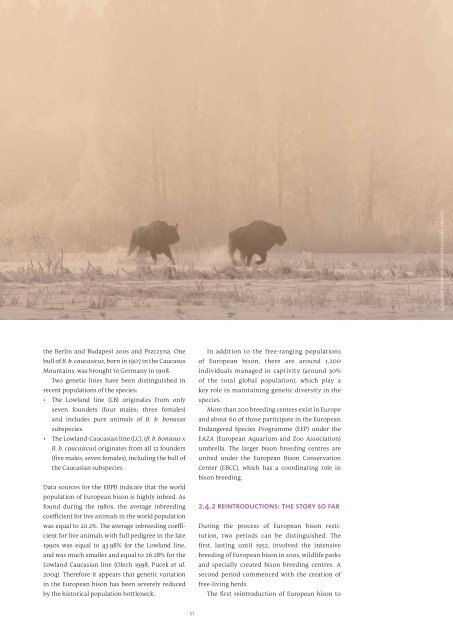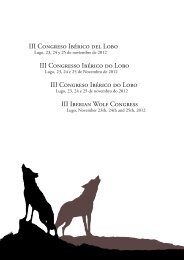Bison-Rewilding-Plan-2014
Bison-Rewilding-Plan-2014
Bison-Rewilding-Plan-2014
- No tags were found...
Create successful ePaper yourself
Turn your PDF publications into a flip-book with our unique Google optimized e-Paper software.
Caption????????????????????????????STEFANO UNTERTHINER / WILD WONDERS OF EUROPEthe Berlin and Budapest zoos and Pszczyna. Onebull of B. b. caucasicus, born in 1907 in the CaucasusMountains, was brought to Germany in 1908.Two genetic lines have been distinguished inrecent populations of the species:• The Lowland line (LB) originates from onlyseven founders (four males; three females)and includes pure animals of B. b. bonasussubspecies.• The Lowland-Caucasian line (LC), (B. b. bonasus xB. b. caucasicus) originates from all 12 founders(five males; seven females), including the bull ofthe Caucasian subspecies.Data sources for the EBPB indicate that the worldpopulation of European bison is highly inbred. Asfound during the 1980s, the average inbreedingcoefficient for live animals in the world populationwas equal to 20.2%. The average inbreeding coefficientfor live animals with full pedigree in the late1990s was equal to 43.98% for the Lowland line,and was much smaller and equal to 26.28% for theLowland Caucasian line (Olech 1998, Pucek et al.2004). Therefore it appears that genetic variationin the European bison has been severely reducedby the historical population bottleneck.In addition to the free-ranging populationsof European bison, there are around 1,200individuals managed in captivity (around 30%of the total global population), which play akey role in maintaining genetic diversity in thespecies.More than 200 breeding centres exist in Europeand about 60 of those participate in the EuropeanEndangered Species Programme (EEP) under theEAZA (European Aquarium and Zoo Association)umbrella. The larger bison breeding centres areunited under the European <strong>Bison</strong> ConservationCenter (EBCC), which has a coordinating role inbison breeding.2.4.2 reintroductions: the story so farDuring the process of European bison restitution,two periods can be distinguished. Thefirst, lasting until 1952, involved the intensivebreeding of European bison in zoos, wildlife parksand specially created bison breeding centres. Asecond period commenced with the creation offree-living herds.The first reintroduction of European bison to21



